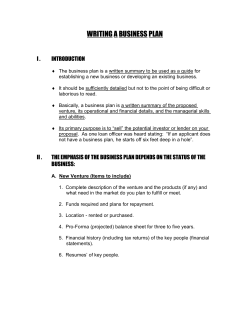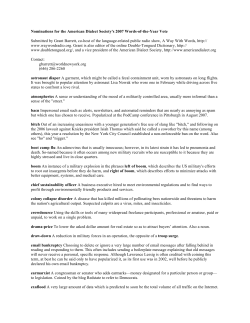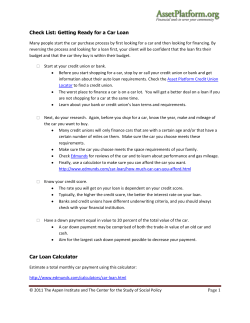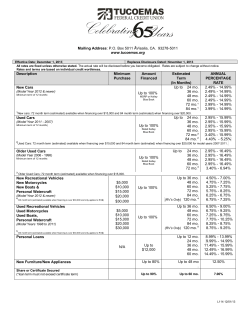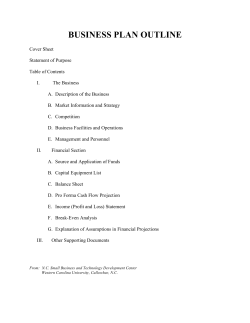
How to obtain Finance from First Women Bank Limited
SMEDA Business Guide Series How to obtain Finance from First Women Bank Limited 2(Fin-5)/R-0 (July 31st, 2003) Prepared By: Policy Planning & Strategy Small and Medium Enterprise Development Authority Government of Pakistan www.smeda.org.pk HEAD OFFICE Waheed Trade Complex, 1st Floor , 36-Commercial Zone, Phase III, Sector XX, Khayaban-e-Iqbal, DHA Lahore Tel: (042) 111-111-456, Fax: (042) 5896619, 5899756 Helpdesk@smeda.org.pk REGIONAL OFFICE PUNJAB Waheed Trade Complex, 1st Floor, 36-Commercial Zone, Phase III, Sector XX, Khayaban-e-Iqbal, DHA Lahore. Tel: (042) 111-111-456 Fax: (042) 5896619, 5899756 helpdesk@smeda.org.pk REGIONAL OFFICE SINDH REGIONAL OFFICE NWFP REGIONAL OFFICE BALOCHISTAN 5TH Floor, Bahria Complex II, M.T. Khan Road, Karachi. Tel: (021) 111-111-456 Fax: (021) 5610572 Ground Floor State Life Building The Mall, Peshawar. Tel: (091) 9213046-47 Fax: (091) 286908 helpdesk-pew@smeda.org.pk Bungalow No. 15-A Chaman Housing Scheme Airport Road, Quetta. Tel: (081) 831623, 831702 Fax: (081) 831922 helpdesk-qta@smeda.org.pk helpdeskkhi@smeda.org.pk Table of Contents Page # Contents 1. Introduction of SMEDA 02 2. Role of Policy Planing & Strategy Department 02 3. Loan Process Flow Chart 03 4. First Women Bank Limited 04 5. Financial Products of FWBL 04 6. Running Finance 04 7. Demand Finance 05 8. Small Loan 05 9. Business Loans for Women 05 10. Home Improvement Scheme 06 11. Information Technology Finance 06 12. Asaish Scheme 06 13. Loans for Salaried/ self-employed Women 07 14. Agricultural Financing 07 15. Non-Fund Based Facilities 07 16. Loan Process 08 17. Annexes Annex- I 10 Annex –II 11-14 Annex-III 15 Annex-IV 16-18 Annex-V 19 1 INTRODUCTION OF SMEDA The Small and Medium Enterprise Development Authority (SMEDA) was established in 1998, with the objective to provide fresh impetus to the economy through the launch of an aggressive SME development strategy. SMEDA initially focused on nine priority sectors on the sole criterion of SME presence and in order to stimulate growth, sector strategies were developed and regulatory reforms were also proposed. In depth research was conducted and comprehensive plans were formulated after identification of impediments and retardants. These strategies as proposed by SMEDA comprehensively covered all important areas of business operation such as regulatory environment, finance, marketing, technology and human resource development. Resultantly, SMEDA successfully formulated strategies for sectors, including fruits and vegetables, marble and granite, gems and jewellery, marine fisheries, leather and footwear, textiles, surgical instruments, transport and dairy. After successfully qualifying in the first phase of sector development SMEDA reorganised its operations in January 2001 with the task of SME development at a broader scale and enhanced outreachreach in terms of SMEDA’s areas of operation. Currently, SMEDA along with sectoral focus offers a range of services to SMEs including over the counter support systems, exclusive business development facilities, training and development and information dissemination through a wide range of publications. SMEDA’s activities can now be classified into the three following broad areas: 1. Creating a Conducive Environment; includes collaboration with policy makers to devise facilitating mechanisms for SMEs by removing regulatory impediments across numerous policy areas 2. Cluster/Sector Development; comprises formulation and implementation of projects for SME clusters/sectors in collaboration with industry/trade associations and chambers 3. Enhancing Access to Business Development Services (BDS); development and provision of services to meet the business management, strategic and operational requirements of SMEs The aforementioned reorganisation of SMEDA is driven by enhanced interaction with the stakeholders and suggests that SMEDA is truly a learning organization and has always been ready to take the lead in SME development arena. ROLE OF POLICY PLANNING AND STRATEGY DEPARTMENT The Policy Planning and Strategy (PP&S) department of SMEDA is the hub of policy and regulatory research that feeds national, provincial and local government institutions, SME associations, industrial clusters and individual entrepreneurs with the ultimate objective of creating a conducive business environment. It has a mandate to identify and where suitable initiate strategic projects. Library and Information resource center of SMEDA is an integral part of PP&S while development of Regulatory Procedures is a part of an overall information dissemination function of the department. One of the major problems that SMEs face and women entrepreneur in particular is regarding availing financing options. The aim of this document is to provide information pertaining to various financing options offered by FWBL along with their lending procedure. This will enable them to be fully comfortable with the procedure of attaining financing facility from FWBL. 2 Loan Process Flow Chart Opening an account with FWBL The applicant has to have/open an account with FWBL in order to apply for loan. Loan Application Form The applicant fills the loan application and submits loanprocessing fee along with required documents. Documents Required 1. National Identity Card Copy. 2. Credit/s stock reports 3. Form 29 & Form A for private limited company. 4. Memorandum & Article of Association for private/ limited company 5. Board resolution signed by all directors in case of private/public Ltd company. Certificate 6. Certificate of incorporation &Business commencement. 7. Partnership deed on stamp paper for partnership concerns. Branch Verification The Branch officer visits the business site of the applicant to verify and assess the project viability. Evaluation and Appraisal Evaluator of the Bank’s choice evaluates collateral. Other Documents Required ( In case of Property) 1. 2. 3. Loan Approval If all acceptable, then the case is forwarded for approval to authorities. 4. 5. 6. Loan Disbursement After approval, loan is disbursed to the borrower. Repayment Repayment of loan starts according to the schedule agreed by the bank and borrower. 3 Original Registry/Transfer letter. Farad Milkiyat (From Patwari/Tehsildar) Non Encumbrance Certificate. (NEC) PT-I Form (From Property Tax Department) Valuation of Property. Legal opinion. FIRST WOMEN BANK LIMITED (FWBL) FWBL was established in 1989 as a nationalized commercial bank to cater to the financial needs of Women Entrepreneurs (WEs). The FWBL was given the task of improving the socio-economic status of women both in urban and rural areas by creating opportunities for their development through enhanced economic participation. FWBL is serving not only as a commercial bank but also is a development finance institution for women in Pakistan. FWBL is currently providing financial assistance to those; 1. Private business operated by women entrepreneurs but not restricted to women 2. Partnership firms or private limited companies in which a) women are 50% shareholders, b) woman is managing director of the company, or c) 50% workers are women FINANCIAL PRODUCTS OF FWBL First Women Bank Limited offers following financial products/schemes to women entrepreneurs. 1. Running Finance 2. Demand Finance i) Small loans ii) Business Loans for Women iii) Home Improvement Scheme iv) Information Technology Finance v) Asiash Scheme vi) Loan for Salaried Women 3. Agricultural Loans 4. Non-Fund based facilities The brief of each of the above mentioned products is as follows: Running Finance Running finance is a short-term finance where a revolving fund limit is provided to the borrower and borrower may withdraw or deposit funds as desired. This loan facility is for the purpose of expansion of business. This multi-transactional account is maintained in borrower’s favour for period of one year. This may be renewable after expiry depending on the turn over and recovery of mark up. The mark up payments are made on quarterly basis. However, the loan amount depends on value of security and business volume. As per rules of FWBL, it retains 25% margin against cash collateral and 50% against property. Eligibility Criteria • Businesswomen between the ages of 25-55 years. • Women in business for at least 5 years, with 50% equity • Women who is or has availed a bank loan, for business purpose • Satisfactory credit history of business loan (if has taken any) • The purpose of obtaining finance should be for investment in business as working capital or for the purchase of fixed assets such as machinery, raw materials etc. • Business loans can be obtained against property, cash and stock as a collateral • In case of financing for working capital, there has to be time-to-time adjustments of principle, with full adjustment to be made at least once a year. • For cases involving purchase of machinery, raw material, etc., repayment period extends from 12 months to 36 months with grace period of (3 months maximum). 4 • The mark-up rate1 ( it is negotiable )depends on nature of security as follows: Mark-up Rate Type of Collateral Mark-up Rate Type of Collateral 11% per annum Cash Collateral 16% per annum Govt. employees salaries under lien 14% per annum Property 18% per annum 2 personal guarantees Demand Finance Finance or a loan that is repayable whenever required or recalled by the lender prior to maturity date is called Demand Finance or Loan. The important feature of this category is that Loan amount is disbursed in lump sum to the borrower’s account (and the borrower may withdraw cash partially, from time to time or entirely in one go). Loan amount disbursed depends on the value of security and volume of business. Mark up and principle repayment mode is negotiable, i.e. it could be either monthly or quarterly etc. Bank retains 25% margin against cash collateral and 50% against property. The demand finance can be utilised for business purposes as well as for domestic purposes. The difference being; for domestic loan only cash collateral is acceptable. Eligibility Criteria Eligibility or lending criteria is the same as that of Running Finance. Various Categories of Demand Finance Facility: In the demand finance category various schemes are being offered by FWBL which are: i) Small Loans The small loans are given up to Rs. 25, 000 and this facility could be availed by existing small businesses. Under this scheme two personal guarantees are acceptable and the physical presence of guarantors is must while signing the guarantee paper. • Eligibility Criteria • The domestic purpose should be clear and well defined and for business purpose, the business should be already existing. • Two personal guarantees preferably of government employees are required. • Stocks double of loan amount are hypothecated as security if loan is obtained for business purpose. • The bank may also take lien on salary of any one of he guarantors • The repayment period of loan is 2 years or 24 monthly instalments. • Annual mark up on the loan is 18%. ii) Business Loans for Women Financing between Rs. 0.1 Million to 0.5 Million for businesswomen. It is available against two personal guarantees. Guarantors having a net worth of atleast Rs. 2 Million, with credentials as acceptable to the Bank accompanied with documentary evidence of assets. • 1 Eligibility Criteria • Businesswomen between the ages of 25-55 years. • Women in business for 3-5 years. • Borrowing: Equity ratio –50:50. • Satisfactory credit history of business loan. • Financing can only be sought for business investment as working capital or for the purchase of fixed assets e.g. Machinery. Mark up rate may subject to change however, mark-up rate and the nature of security can be negotiated. 5 • The mark up rate for this loan is as follows: Against Cash Collateral: 13% p.a./ Against Property: 16% p.a./ Against Jewellery: 18% p.a./ Against Pledge: 18% p.a. iii) Home Improvement Scheme This scheme provides loan facility for home improvement. Maximum loan limit is Rs. 200,000. It is available against mortgage of concerned house and two personal guarantees are required. • Eligibility Criteria • Eligibility is based on the evidence of regular income source. • House should be owned by a female or in joint name of male and female. • Loan repayment period is 1 to 5 years or 12 to 60 instalments. The instalment should not exceed 1/3rd of take home salary. • The mark up rate is 16% p.a. (Mark up rate may subject to change at any time) Documents Required • Attested copy of NIC • Salary certificate from employer • Sale deed/ Title deed/ Transfer letter • No Objection Certificate (NOC) • Non Encumbrance Certificate • Aks Shajra • Fard • P.T I Form from Property Tax Department • Site Plan iv) Information Technology Finance This loan facility may be utilized by firms, individuals and students. In this way this facility can be utilised for business as well as domestic purposes. Loan amount is determined by the category of borrowers. • Individuals (Qualified professional users, businesswomen, and domestic user). • Women employees of Govt. institutions / Autonomous & Semi autonomous bodies, Multinational and Public Ltd can apply for loan. • Borrower’s salary is underlien. • One personal guarantee is required. • Cash Collateral and property both acceptable. • Repayment period is 1 to 2 years. • Students ( purpose-payment of tuition fee) • Students of recognised Federal & Provincial Govt Institutions can apply. • Two personal guarantees and recommendation of parents/ guardians required. • Repayment period is 1 to 3 years depending on the course duration. • Both cash and property are acceptable as collateral. • Mark up rate depends on nature of security: • 16% against property. • 13% against cash collateral. • 18% against other assets (e.g. paper security, hypothecation etc) v) Asaish Scheme Asaish Scheme is available for buying electrical appliances up to value of Rs. 50,000 maximum. The duration is between 1-3 years and personal guarantees of Government employees are also required for it. 6 vi) Loans for Salaried/Self Employed Women FWBL provides financing to salaried women on easy terms. Financing is provided up to Rs.50, 000. Women may apply jointly with her spouse or next of kin. Spouse’s income will be combined with that of applicant, to determine the loan amount and repayment capacity. Repayment period for this scheme extends between 1- 3 years, depending on the applicant’s requirement. • Eligibility Criteria • Salaried women should be between ages 25-55 years. • Monthly repayment not to exceed 1/3rd of employees Take- Home salary. • Employee should have a service contract valid for 18 to 36 months at the time of applying for loan and be in service for the past 3 years. • Two personal guarantees and the guarantors should be of sufficient capacity to repay. • Employer has to give an undertaking that her/his salary will be deposited into the account with FWBL each month. • Employer shall have to assign his/her Provident Fund/Retirement Benefits in the Bank’s favour. • The loan repayment period is 2-3 years. • The mark up rate is 16%. Documents Required. • Attested copy of NIC • Salary Certificate with details of deduction duly certified by the employer. • Income Tax certificate • Bank Statement for the past 12 months. • Life Insurance Policy of sufficient amount in the favour of FWBL. • Confirmation from department that they continue to send salary in FWBL account till adjustment. Agricultural Financing (rural based) Agricultural finance facility is purely for business purpose and further classified into; 1. Production Finance Under this scheme finance is provided for purpose of buying seeds, fertiliser, pesticides and insecticides etc. This finance can be availed for a particular crop or season and it has to be repaid in 2 months after harvesting. 2. Development Finance Development finance is provided for purpose of tractors, tub-well, farm machinery and land improvement. In this case financing is done for a period of 18 months to 7 years, depending upon purpose of loan. Usually finances are allowed for 3 years, repayable in half-yearly instalments. Non- Fund Based Facilities 1. Letter of Credit FWBL is providing facilities of various types of Letters of Credit, Acceptance L/C, Negotiation L/C, and Back-to-Back L/C for their clients. 2. Bank Guarantees Bank also is issuing various types of guarantees such as; performance Guarantee, Bid Bond, Shipping Guarantee, Guarantees for Advance Payments, Mobilisation Guarantees, Security Deposit Guarantees, Guarantees for Payment of dues/ court Guarantees. These guarantees are only issued for clear and well-defined purpose. Guarantees are issued in favour of shipping companies, Govt. Departments, guaranteeing specific payments at future dates by customers on whose behalf the guarantee are issued, or guaranteeing completion of a particular performance by the customers. Guarantees are issued against 100% cash margin. 7 LOAN PROCESS Step 1 • To apply for any kind of loan to FWBL, the applicant must have an account with the bank. • If not, new current account has to be opened with an amount of Rs.1, 000 • The applicant submits loan application (Annex I), along with the following documents. • Attested copy of NIC • Original Business Plan • Bank statement for past 6 months • Financial statement for the past 3 years • Borrower’s Basic Fact Sheet (Annex II) • Stock reports (Annex III) • Credit Report (Annex IV) • If property is offered as collateral following additional documents are required • Sale deed/ Title deed/ Transfer letter • Non Encumbrance Certificate • Fard Milkiyat • P.T I Form from Property Tax Department • Against cash collateral, required documents are • Defence Saving Certificate (DSC) along with letter of pledge. • Special Saving Certificate (SSC) along with letter of pledge. • National Saving Certificate (NSC) along with letter of pledge. However, specific scheme may require other documents to be submitted to the bank which have already been mentioned while discussing the various schemes. Step 2 • The processing fee charged for different services vary from Rs. 2000 to Rs. 3000. • The applicant fills the application form along with the Borrower’s Basic Fact Sheet. (Annex I & II) • The applicant has to attach the required documents according to the loan scheme she is applying for. The applicant must be very careful in this regard as the required documents vary from scheme to scheme. Step 3 • After the loan application is received, the credit department goes through the application. • Two branch officers visit the business sight of the applicant to check the project viability and verify the sight as well. Step 4 • After the branch verification, the credit department carries out the evaluation and appraisal of the loan request. • The bank obtains legal opinion certificate from the lawyer for the clearance of the title of applicant’s property in case of property offered as collateral and gets it evaluated from professional evaluator of its own choice. • If all this turns out to be positive, the case is forwarded to the approval authority. Step 5 • The regional office approves the loan up to Rs.450, 000 against cash collateral while head office approves loan above Rs.450, 000 against cash or property. • If the loan the loan is sanctioned, then 1. Legal documents are prepared and executed. 2. The collateral is mortgaged in bank’s favour. 8 • 3. If necessary, the bank takes lien on salary of borrower/guarantor. 4. The business assets/stocks/immovable assets may be hypothecated or pledged as required by the bank. The loan is disbursed to the borrower. 9 Annex (I) 10 Annex (II) Page 1of4 of Annex (II) 11 Annex (II) Page 2of4 of Annex(II) 12 Annex (II) Page 3of4 of Annex(II) 13 Annex (II) Page 4of4 of Annex(II) 14 Annex (III) 15 Annex (IV) Page 1of3 of Annex (IV) 16 Annex (IV) Page 2of3 of Annex (IV) 17 Annex (IV) Page 3of3 of Annex (IV) 18 Annex (V) 19
© Copyright 2025

